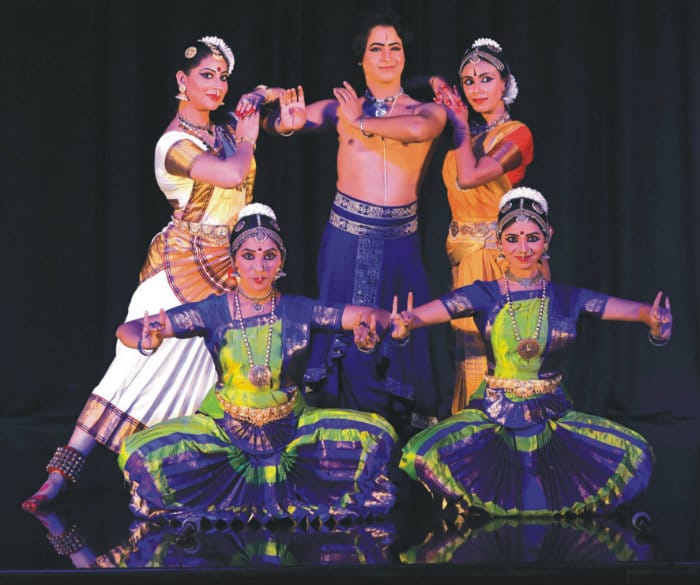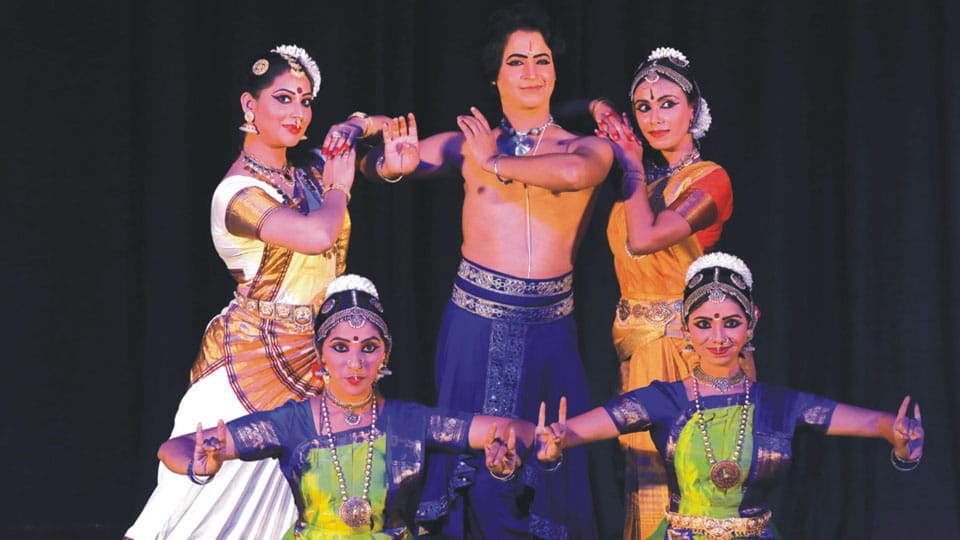Mysureans philosophy of TIE (Take It Easy) and belief in IST (Indian Stretchable Time) should not brand them as insensitive to art and culture. The fact that the threat of the unseasonal and unprecedented thunder and shower did not deter the rasikas to savour the Indian Classical Dance Art at the Articulate Festival in its series 17 on Oct.15 at Mysuru, in itself seals the tag Mysuru ‘Cultural Capital of Karnataka’ more firm.
Further proved correct by seeing nearly 90 percent of the prekshakas always stayed till the end of the programme. ‘Mission accomplished’ and ‘efforts worthwhile’ says the organiser Mysore B. Nagaraj who claims that this is the only dance festival in the city of Mysuru religiously conducted every month on the 3rd Sunday sans any chief guests, sans award ceremonies but pure bliss of experiencing the hoary Indian dance art.
Pavithra Kannan, disciple of Karnataka Kalashree Guru Minal Prabhu, invoked the deities with a bouquet of Musical notes where the drops of dance syllables glistened on its petals and danced like a gentle breeze giving a good start to the evening concert series. She danced all the “Jaathis” of the “Taala” and moved through in tishranadai in the composition “Swara Guccha.” Her dance of a Keerthane “Kaalai Thooki” in Bhagayashree raga and roopak tala, a composition of Sri Muthu Thandavar describing the beauty and attributes of the cosmic dancer Shiva and the bliss experienced by the Munis witnessing, was enchanting to watch especially through her Kalakshetra style of Bharatanatyam. Her concluding repertoire was a Purandaradasa devaranama “Jaganmohanane Krishna” where one could see her calibre in her abhinaya and gleefully questioning Ranga through Haridasas poetry, where he learnt the tricks of Stamping Kaliya, Lifting Mountains, and holding up the mandara during Amruta Mathana.

Seen in the picture are (from left-standing) Shruthi Iyer, Laxminarayan Jena, Pavithra Kannan; (sitting) Samudyatha and Samanvitha.
Shrruthi M. Iyer brought the essence of Kerala, on the stage through her languorous movement like swaying of the palm trees, swinging hands like the flapping of elephant’s ears, fluttering with her bewitching eyes like those of the expressive eyes of Kathakali story-tellers, the stillness in her satvika abhinaya like the still backwaters. The Dance of the enchantress fully justified in her Mohiniyattam short concert. A discerning disciple of Karantaka and Kerala Kalashree Guru Sreedevi Unni, Shrruthi Iyer, even with her dainty footsteps, pleaded mother earth to forgive her for stamping during her gentle dance footsteps while displaying “Cholkattu” characterised by its minimalist beauty and geometry. Radha chastising Krishna for making her wait and asking him to go away was her choice after nrutta to exhibit her calibre in abhinaya. Radha taunted that would he leave alone a love-struck women from killing her with pain of separation when he dared to kill women like Putana. Oh Keshava go away. Shrruthi’s interpretation of Jayadeva’s “Yahi Madhava, Yahi Keshava” was feast-full.
It was Laxminarayan Jena, disciple of Mysore B. Nagaraj, who set the stage on fire with his Tandava and created transitory melancholy with his abhinaya in the third segment of the Festival in Kathak classical dance format. The string of “Chandas” and “Kaviths” went through a gamut of virile, volatile, explosive, destructive, benevolent, meditative, creative, thunderous emotions depicting a array of Shiva’s moods. This dance number was way different from the usual performance of Kathaks which looks more like prancing than dancing, Jena’s performance was in one word “Awsome.” The reverberance of the ankle bells precisely matching the percussion beats was in perfect sync while the torso and limbs moved to the meaning of the poetry, created a fleeting canvas that transited into different textures and colours with different nrutta and nrutya compositions weaved through the tapestry. One would squirm in their seat to watch a male dancer enacting the emotions of a Nayika. Laxminarayan’s expression of frustration of Radha was restrained, subtle and dignified in his rendition of “Radha Bhava Madhava” in Gath Bhav format of Kathak. His, seeking Krishna to become Radha, just for a moment, to realise the pain of separation as experienced by Radha, was just phenomenal. Transiting from male character to female with just a turn of the body and the flip of the veil which he manipulated in a extremely interesting way was the litmus test to his dance calibre. He won unscathed. He was just cool with hot dancing.
What a contrast between Kalakshetra style and Padma Subramanyam’s style of Deccan’s classical dance. No wonder Dr. Padma Subramanyam terms her dance as Bharathanrutya when we see sisters Samudyatha and Samanvitha performing a Varnam on Lord Shiva as trained by Dr. Padma. This seamless performance was extraordinarily beautiful to watch them performing Ananda Tandava — In the pallavi and in the anupallavi describing the formlessness aspect of Shiva. In the Charana, they perceived Shiva in shades of a gruhastha in Mount Kailasa and shades of a Yogi as Dakshinamurthy enunciating the Vedas. Sri Ramadasa’s shloka on Shiva was the opening move. The Charis and Karnas was woven into the fabric of the varnam that one could see the interplay of the sahithya and the nrutta with no defined transit boarders but was a fused blend that gave the beauty of continuity of movement, and intensely justified by the artistes. The mirror image stances and synchronous movements in the choreography, to Samudyatha and Samanvitha was like a child handling her favourite doll with great ease and passion.
Couple of learned spectators expressed this was one of those festivals of the highest artistic levels one can see in this royal city and that too so religiously regular.








Recent Comments